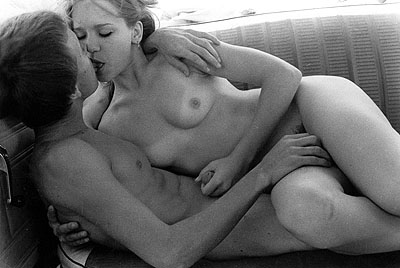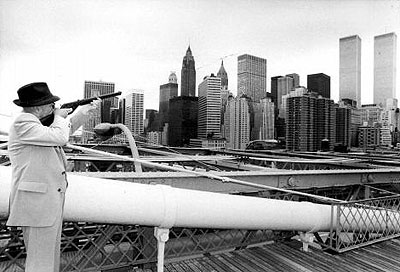
4s: Ahimsa, Oyster Bay, 2006
C-print
11 x 14 inches
In my solitude
Norbert Briar » Larry Clark » Isabelle Lévénez » Gerard Malanga » Karine Marenne » Suzanne Opton » Pierre Radisic » Jens Semjan » Cindy Sherman » Gao Shiqiang » Malick Sidibé » Laurie Simmons » Pépé Smit » Bert Teunissen » CHEN Wei » DONG Wensheng »
Exhibition: 16 Nov 2007 – 12 Jan 2008
AEROPLASTICS contemporary
32, rue Blanche
1060 Brussels
AEROPLASTICS contemporary
rue Vanderkindere str 207
1180 Brussels
+32(0)2-5372202

Untitled, from the series Teenage Lust, 1976
Vintage Silver Print
In a society in which people are connected to one another like never before in the history of mankind, does the term “solitude” still have any meaning? The works in this exhibition do not attempt to answer this question, but each one provides in its own way some reflections on the uniqueness of the human being, his conflicting or complicit relations with others and with the world: “Solitude lies at the lowest depth of the human condition. Man is the only being who feels alone and the only one who is searching for the Other” (O. Paz). For her “Soldiers” series, Suzan Opton photographed American soldiers back from Afghanistan. The photos are identified by a name and the number of days spent at the front: each individual is unique, just as the experience of one is not the same as that of the other. War seems to be continuing behind the open or shut eyes of these faces shown in close-up, resting on the ground. All the armies in the world can glorify the solidarity between soldiers as much as they want: the result is always a little more solitude. The best Hollywood films on the subject developed this paradox to absurd lengths, from the “Deer Hunter” to “Full Metal Jacket”, which Jens Semjan revisits with “Vietnam, The Movie”, a symbolic scene – or rather scenes, since this is a collage halfway between animated and fixed images. With its panoramic format, the image also refers to the history of art and to “war paintings”, a genre that has now been replaced by the cinema, and which bears witness to the morbid fascination which war has always wrought on the general public, regardless of era. This attraction to death is also a feature in the passage into adulthood, as Larry Clark has illustrated in his series “Dead”. With “Teenage Lust”, he studies the apparent insouciance of teenagers in their discovery of sex and drugs. These images must be looked at in the wider context of his work which depicts the frantic quest to belong to a group at this time of life. Clark’s images have often led to controversy since his models are children. Dennis Kardon seems to enjoy these politically correct controversies by playing with the proportions of his characters (“Pop Quiz”, 2005), causing some unease in the spectator. In his recent videos, Gao Shiqiang questions the status of the individual in his relationship with the community, in the context of the huge changes in contemporary China, an approach that can also be perceived in the photographs of Chen Wei and Dong Wensheng. The work of the latter points to the obvious influence of traditional Chinese painting combined with reflections on the development of individuals in the specific context of a given environment. As for Zhou Xiahou, his animated film takes the two extremities of a love affair and focuses on a single image and a single body, with the man and woman meeting and clashing; the conflict is depicted lightly and humorously. The same could be said of Karine Marenne’s video, an integral part of her “Caravan of Love” project: this moving and living sculpture deals humorously with topics relating to femininity and couples. For instance is not the radiant woman at home alone with her sophisticated domestic appliances sheltered from the blues and from her fantasies? Stereotypes linked to femininity are also at the heart of the work of Pépé Smit, as can be seen from her self-portrait using make-up in a modern, contemporary art museum. Gerard Malanga’s photographs speak of the solitude of their models, caught in their full glory: Andy Warhol, Iggy Pop, William Burrough, but above all Edie Sedgwick, alone in the Photomaton cabin. For Norbert Briar, however, the anonymity of those in the portraits matches that of the décor, chosen precisely for its ordinariness. While their solitude seems total, the game of seduction that these young girls play with the photographer brings them amazingly close to the spectator. The “domestic landscapes” which Bert Teunissen has produced in various countries (Belgium, the Netherlands, Japan, etc.que, Pays-Bas, Japan, etc.) also praise the ordinary, but here the décor reflects the personality of the models down to the smallest detail. In the portraits by Malick Sidibé, each model’s special features are indicated by their possessions: clothes, portable radios or motorbikes – a principle which Cindy Sherman delights in distorting in her “bus riders” series where she disguises herself and embodies each “model” in turn. Lastly, there are the “intimate panoramas” and “portraits of emotions” in the photographs of Isabelle Lévénez, such as her self-portrait entitled “Narcisse”. This description could just as well apply to mages of a quite different type, the “Pornscapes” of Pierre Radisic. A doll’s house furnished by big designers (Ron Arad, Karim Raschid, Jasper Morrisson, Le Corbusier, etc.) and decorated by very typical contemporary works (Allan McCollum, Barbara Kruger, etc.), the “Kaleidoscope House” by Laurie Simmons (available in shops in a simple version) recounts in a play the solitude of this family condemned to live in a décor designed for it – to the extent that even the children’s toys consist of rare, expensive items. A kind of golden cage, contrary to the traps tirelessly produced by Andreas Slominski, which are allusions to the seductive, disappointing nature of art, and which reveal everything about their imprisoning function. There is no doubt that Gavin Turk is better known in the world of contemporary art than Ian Rank-Broadley. Yet the latter’s works - effigies of Queen Elizabeth for the United Kingdom Mint – are seen by millions of English people every day. However, it is Turk, who has produced only five examples of one of these coins in solid bronze, fifty centimetres in diameter, whose name is remembered. If this injustice, and the solitude of the great misunderstood artist, should weight too heavily on the shoulders of Rank-Broadley, there is one solution: take Dana Wyse’s “Accept That You're Absolutely Alone” pill. P-Y Desaive

